The Intel Haswell-E CPU Review: Core i7-5960X, i7-5930K and i7-5820K Tested
by Ian Cutress on August 29, 2014 12:00 PM ESTCPU Benchmarks
The dynamics of CPU Turbo modes, with both Intel and AMD, can cause concern during environments with a variable threaded workload. There is also an added issue of the motherboard remaining consistent, depending on how the motherboard manufacturer wants to add in their own boosting technologies over the ones that the CPU manufacturer would prefer they used. In order to remain consistent, we implement an OS-level unique high performance mode on all the CPUs we test which should override any motherboard manufacturer performance mode.
HandBrake v0.9.9: link
For HandBrake, we take two videos (a 2h20 640x266 DVD rip and a 10min double UHD 3840x4320 animation short) and convert them to x264 format in an MP4 container. Results are given in terms of the frames per second processed, and HandBrake uses as many threads as possible.
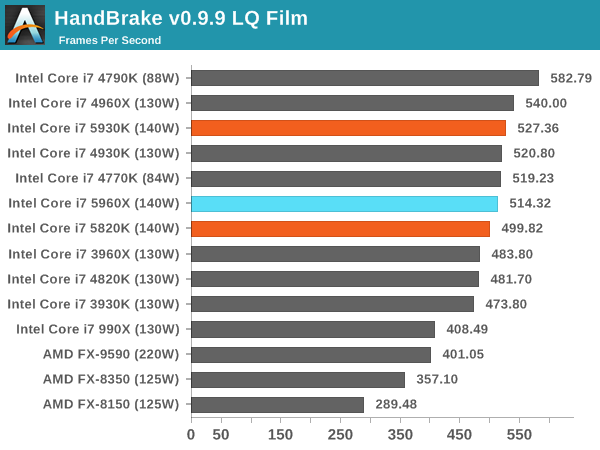
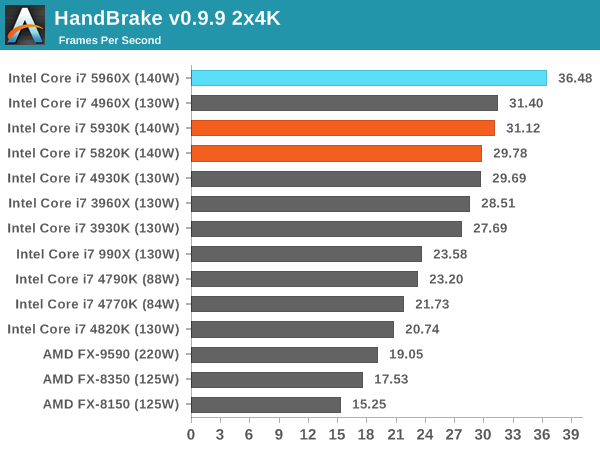
The variable turbo speeds of the CPUs results in a small difference in low quality conversion, and the high single core frequency of the 4790K wins there. For 4K conversion the problem becomes more parallel and the extra cores of the 5960X push it ahead of the pack. The 5930K and 5820K are both behind the 4960X however.
Agisoft Photoscan – 2D to 3D Image Manipulation: link
Agisoft Photoscan creates 3D models from 2D images, a process which is very computationally expensive. The algorithm is split into four distinct phases, and different phases of the model reconstruction require either fast memory, fast IPC, more cores, or even OpenCL compute devices to hand. Agisoft supplied us with a special version of the software to script the process, where we take 50 images of a stately home and convert it into a medium quality model. This benchmark typically takes around 15-20 minutes on a high end PC on the CPU alone, with GPUs reducing the time.
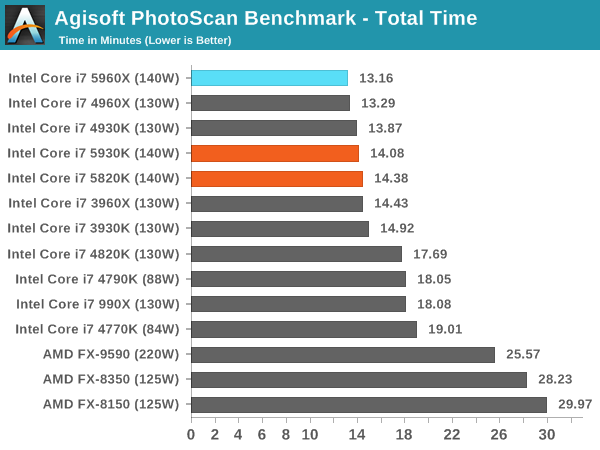
Photoscan's four separate components rely on different amounts of high frequency vs. many cores: check our Bench database for more detailed results but overall the 5960X comes out on top. That being said, the 5820K is less than 40% of the price and is only 1.2 minutes behind.
Dolphin Benchmark: link
Many emulators are often bound by single thread CPU performance, and general reports tended to suggest that Haswell provided a significant boost to emulator performance. This benchmark runs a Wii program that raytraces a complex 3D scene inside the Dolphin Wii emulator. Performance on this benchmark is a good proxy of the speed of Dolphin CPU emulation, which is an intensive single core task using most aspects of a CPU. Results are given in minutes, where the Wii itself scores 17.53 minutes.
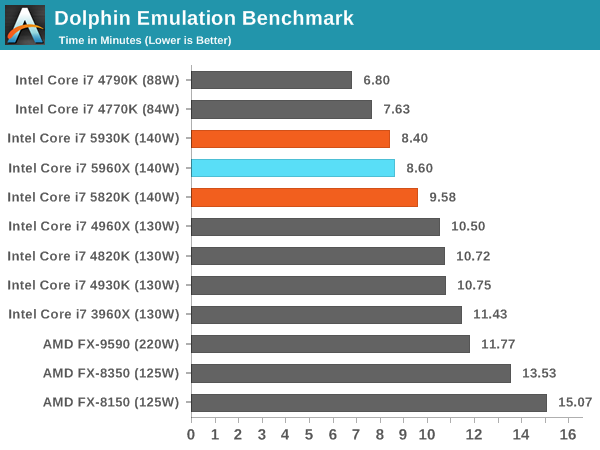
Dolphon loves single core speed and efficiency, meaning the 4790K wins out again. Interestingly the large L3 cache of the 5960X also helps here against the 5820K, despite the 5820K having a higher single thread frequency.
WinRAR 5.0.1: link
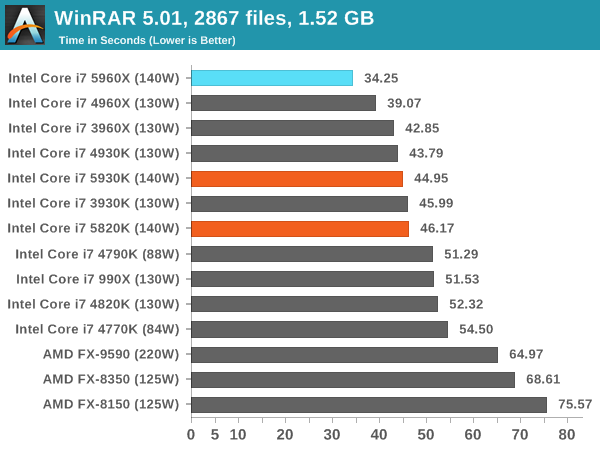
WinRAR is a variable thread workload, but more cores still wins out. Interestingly the xx60X CPUs are ahead of the xx30K CPUs followed by the xx20K. After this comes the 4790K, and then the 990X on par, showing how far three generations of Intel CPU have developed.
PCMark8 v2 OpenCL
A new addition to our CPU testing suite is PCMark8 v2, where we test the Work 2.0 and Creative 3.0 suites in OpenCL mode.
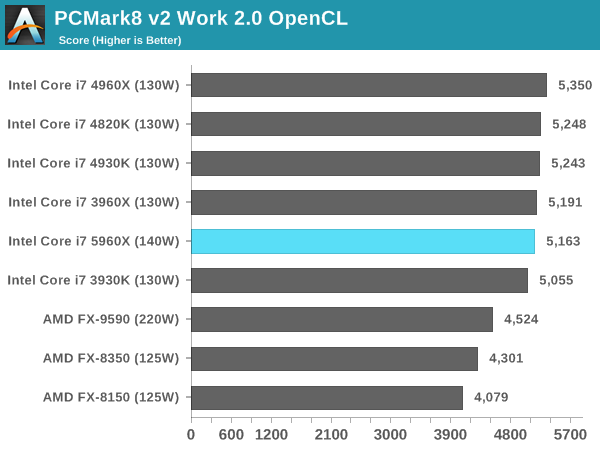
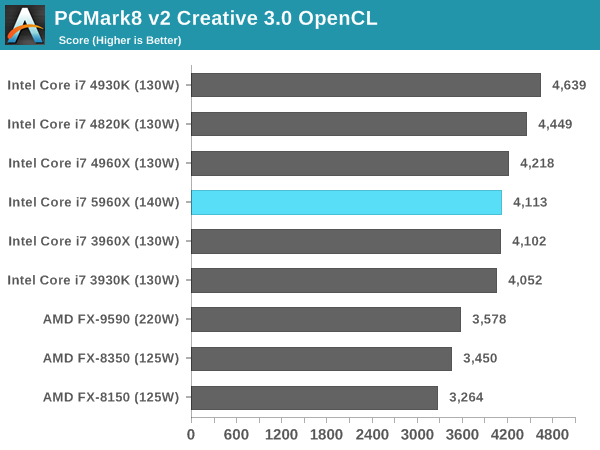
PCMark v8 relies on a number of factors, and it would seem that frequency is preferred over cache and memory. Interestingly the 4930K beat the 4960X in the Creative Suite with no obvious explanation.
Hybrid x265: link
Hybrid is a new benchmark, where we take a 4K 1500 frame video and convert it into an x265 format without audio. Results are given in frames per second.

Converting 4K video gets another step in the preference for more cores in Hybrid x265. The 5820K matches the 3960X, showing the progression of CPU generational development.
Cinebench R15
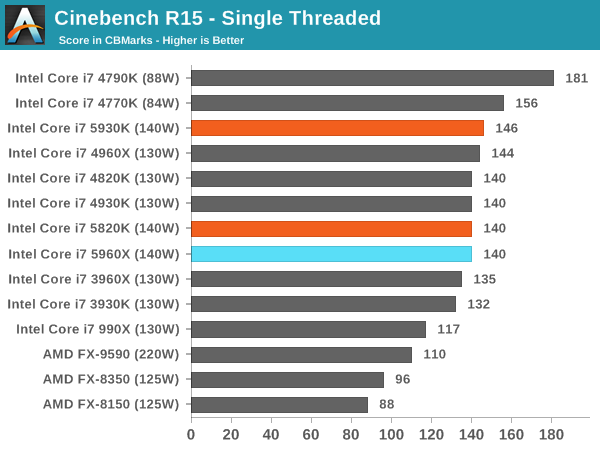
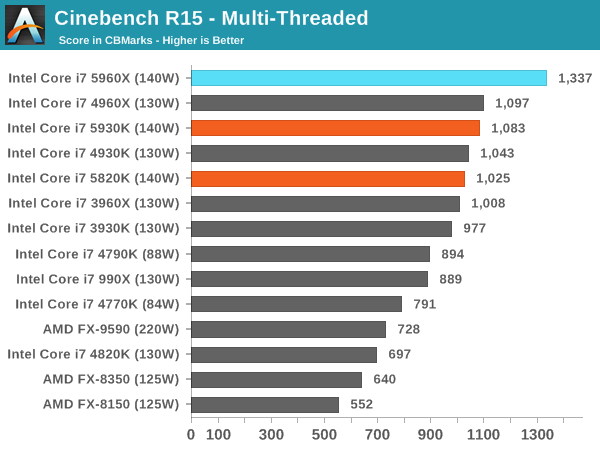
3D Particle Movement
3DPM is a self-penned benchmark, taking basic 3D movement algorithms used in Brownian Motion simulations and testing them for speed. High floating point performance, MHz and IPC wins in the single thread version, whereas the multithread version has to handle the threads and loves more cores.
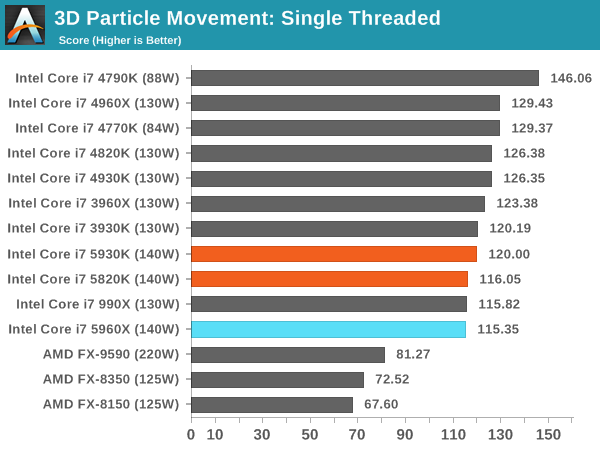

FastStone Image Viewer 4.9
FastStone is the program I use to perform quick or bulk actions on images, such as resizing, adjusting for color and cropping. In our test we take a series of 170 images in various sizes and formats and convert them all into 640x480 .gif files, maintaining the aspect ratio. FastStone does not use multithreading for this test, and results are given in seconds.
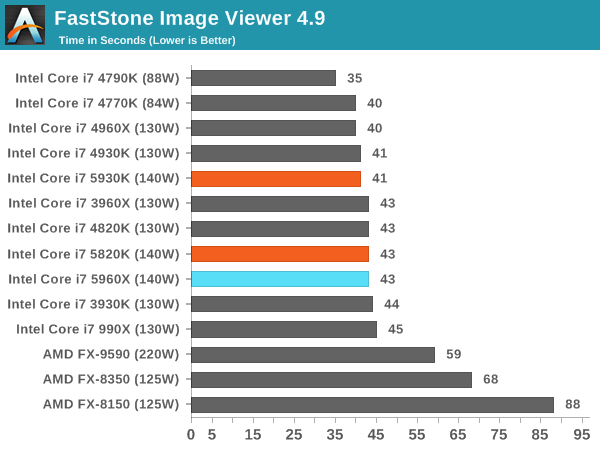
FastStone is a purely single threaded exercise, showing here how the lower core CPUs with high turbo perfom best, and by quite a margin.










203 Comments
View All Comments
MrBungle123 - Friday, August 29, 2014 - link
Is there anything but 'edge case' justification for upgrading any more? PCs used to be exciting because things were always changing, this is just getting boring.edzieba - Friday, August 29, 2014 - link
VR. The frame rendering time requirements are pretty stringent. This is more on the GPU than the CPU for graphics, but you want to try and keep physics tics at a good rate to prevent objects jumping around the world.tech6 - Friday, August 29, 2014 - link
Even the 'edge case' is not longer a slam dunk as most workstation workloads like CAD do very well on the 4960X.The only real cases are heavy scientific number crunching, animation rendering and cracking password hashes by brute force.
MrBungle123 - Friday, August 29, 2014 - link
It used to be that if you were 2 generations behind your system was so slow and irrelevant that you just couldn't run modern software at anything approaching an acceptable level. Now we have a situation where ancient systems on X58 (circa 2008) are still close enough in performance to the extreme high end in 2014 to not only be in this review but also fit somewhere into the top half of the product stack of modern Haswell based hardware.If you compare a top of the line Nehalem chip to its equivalent from 6 years prior (a Northwood core P4 from 2002) it would make a mockery of 8 of them at the same time. This article is saying a 31% jump from Nehalem to Haswell-E -- that kind of performance increase (as a percentage) would have amounted to 2 or 3 months worth of clock speed bumps at any other time in the history of PCs.
wireframed - Friday, August 29, 2014 - link
Somewhat true, but consider that you get 30% IPC increase, 25-30% frequency increase and a 50% core-count increase, and it adds up to around a 100% increase in performance.Granted, 100-110% over 6 years is hardly impressive compared to earlier, but there isn't that much low-hanging fruit.
Also, the mainstream which drives revenue is, as you point out, largely content. They're looking at adding devices like tablets and consoles, instead of upgrading their computers. That probably plays into the amount of R&D Intel decides to spend on the HEDT platform.
Kain_niaK - Friday, August 29, 2014 - link
Exactly exactly exactly! I am still on X58 with a i7 990x. I don't play much games any more but even to play the newest games ... I do not need to upgrade my CPU and have not needed to upgrade my CPU since 2010. And even my i7 975x or a i7 920 from 2008 would still be more then fast enough. Then music. I use my system mainl as Digital Audio Workstation. Most of my plugins and music applications support multithreading. I cannot realistically ad so much stuff to a project that it maxes out the CPU. And rendering time? Who cares, most of my renders are done before I am done playing chess on the toilet anyway. Then overclocking. The i7 920 and anything on X58 was great. After that ... the fun and the excitement kind of went away and has never come back. What's the SUPERPI MOD record these days? I have not heard about any significant record breaking for a long time. Back in 2008, 2009,2010 I was hearing news about famous new overclock records. After that, it stopped. Let's face it. We hit a clock limit and for a breaktrought in singlethreated speed ... it's just not gonna happen until some genius designs a totally different system. Probably not using electricity but light. But that's like 20 years away because you don't just start over. All we have been doing is improving old technology not inventing something completely new. We are hitting the limits of nature ... so all the geeks and the nerds will just have to way at least another 10 years before we get to the exciting stuff again.MrBungle123 - Friday, August 29, 2014 - link
At this rate 10 years from now any Haswell i7 is still going to be within spitting distance of whatever the best is. lolIf you wan't Skylake performance today OC your Haswell by 250MHz, Ivy Bridge by 400MHz, or Sandy Bridge by 600MHz.
Laststop311 - Saturday, August 30, 2014 - link
it wont be the cpu performance difference that makes u upgrade it will be the new features. Skylake will have pci-e 4.0 and usb 3.1 and then chipsets after that will add more new things faster storage standards and who knows what else.I was already in this position. The speed of the i7-980x was still rly good. Got mine oc'd to 4261mhz. But guess what on x58 you get not pci-e3.0 no sata 3 no usb 3.0. These features have become very standard. You also get no sata express or pci-e ultra m2 which will soon be commonplace as well as no quad channel memory and no ddr4. All the missing features made me upgrade, not the speed. Similar situations in the future will cause people to upgrade every 4-6 years.
TiGr1982 - Tuesday, September 2, 2014 - link
You can still plug the PCIe USB 3.0 extension board there and get at least 2 USB 3.0 ports on the back of the case, to somewhat mitigate the age of the platform.But, with PCIe 2.0 and SATA 2, one is stuck, indeed.
actionjksn - Saturday, August 30, 2014 - link
Nehalm was great, but the last big bump was really Sandy Bridge. After that, not so much. This is actually a big concern for the processor makers. The technology and the silicon itself is reaching its limits as far as making significant gains on the next generations. They were getting big performance gains from just die shrinks alone, but those days are over. And how much more can they shrink them? It's getting harder all the time, they may get to 7nm to 10nm.